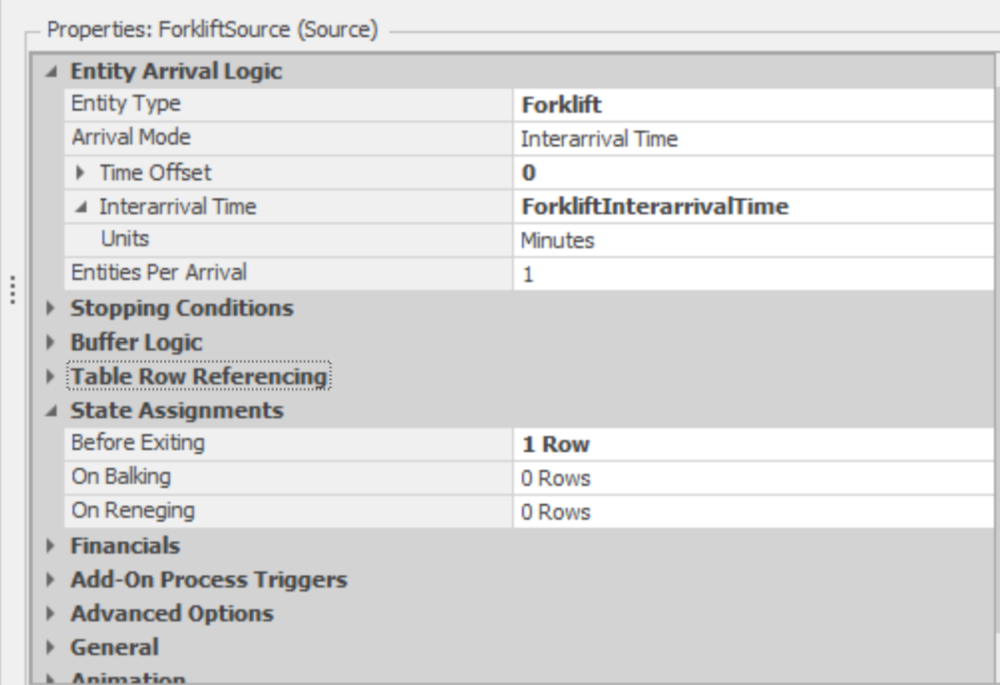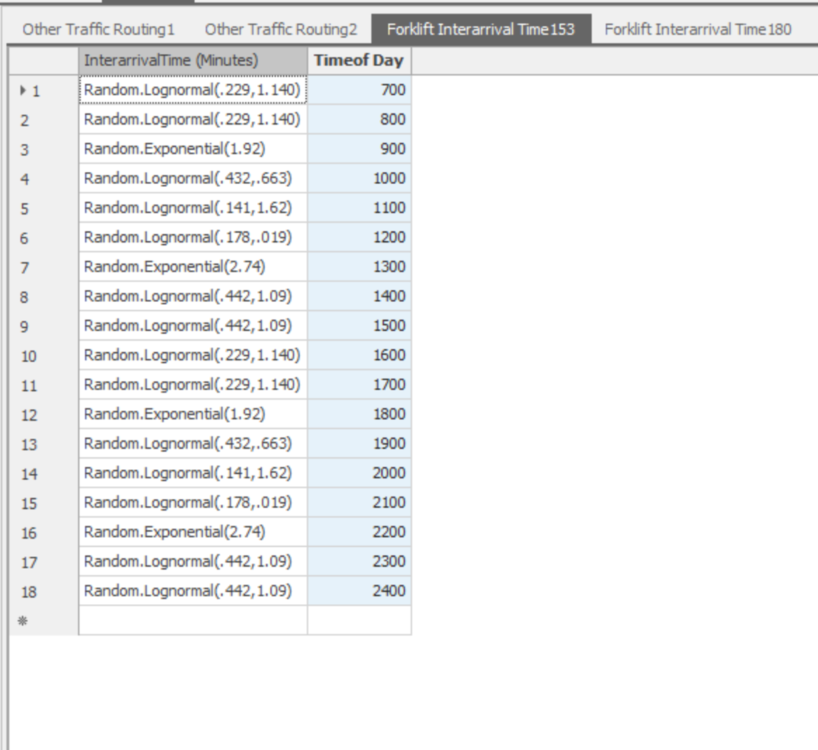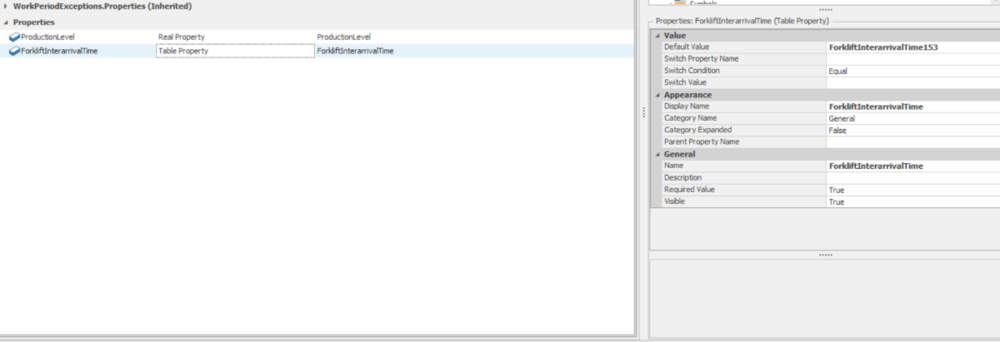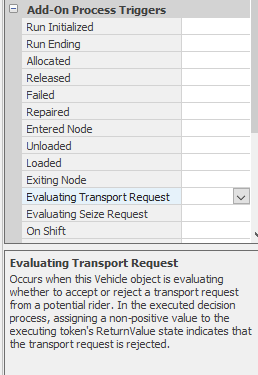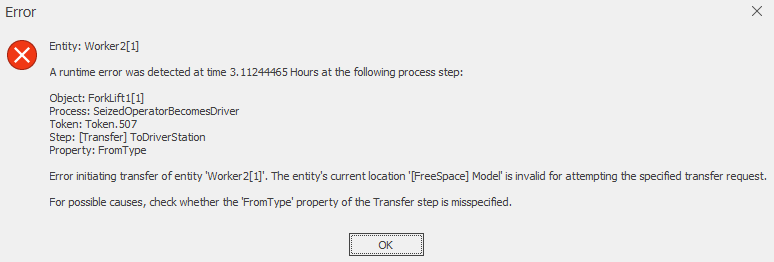Search the Community
Showing results for 'forklift and work on board'.
-
Hello, I am trying to model a situation when a truck which comes for unloading and requires a worker or combination for worker to do the task. Basically I want to know how can I engage secondary resource (Worker or forklift) for loading, unloading or even for transit ( transit I require for cranes ). I am a novice in Simio and will be thankful for any kind of help.
-
People often want to model two or more vehicles or entities moving together. There are a few components to this: 1) Seizing the resource appropriately - can be done in processes, but often best done within the vehicle object to make the modeling easier. Here, a vehicle has 4 properties added to support use of an operator. 2) Animating them moving together - the picture below shows use of a second queue animated on the custom vehicle. 3) In some cases, you also need the "driver" to be shown moving. The Attached Animation Speed illustrated below, accomplishes that. I have attached a model that uses a custom vehicle object to model a wheelchair which is "driven" (pushed) by a person to pick up a patient. *********** FOR VERSION 190 AND EARLIER ************************************* VehicleWithDriver.spfx You could use the same approch, possibly with just animation changes, to model something like a truck or forklift that requires a driver. In fact, I just added a second model to that same project that illustrates use in manufacturing (e.g. a lift truck and driver).VehicleWithDriver.spfx VehicleWithDriver.spfx *********************************************************************************** ************** FOR VERSION 191 AND LATER *********************************** VehicleX3.spfx VehicleWithDriver_VehicleX3_Examples.spfx For more information on the update, see the post below. ***********************************************************************************
-
I have a source, called forklift source, that has a varying interarrival time based on the time of day. To do this, I created a time indexed table with the different interarrival times in different rows and the interval period set to one hour. This source also depends on the interarrival time of another source called Newtrucksource, but not on an hourly basis. I am trying to conduct an experiment where the interarrival time of newtrucksource changes with different experiments and a different time indexed interarrival table for source 1 is used for each of these different interarrival times. To do this, I created a real property for newtrucksource's interarrival time and a table property for forkliftsource's time indexed interarrival table. However, I can't get this to work because in the model, the interarrival time property for the forkliftsource must be a "number" and I am referencing a table which comes up as using "string". Trying to find a way to make this work.
-
Hi All,
I have defined the input buffer capacity and output buffer capacity for my servers, If the input buffer of destination server is full the vehicle still picks the entity(from output buffer of previous server) and moves to the destination(next) server and just waits with the entity unless input buffer capacity is available , how can I restrict the forklift from not picking up the entity or should only pick when the next server/destination has input buffer capacity available. any thoughts on this would be helpful.
-

Entity Distance travelled on Transporter
ttarkan replied to ttarkan's topic in SI General Discussions
Hi again Liz. I found the problem but it wasn't easy to figure out with the RowForKey formula. I used the search function with tablerows as collection type. When I filtered the trace on the search and tally process, I found that the the table index of the found item and index of the search function was not the same in some cases especially for "small" type products. Further even the available row count of the products table was not returning the correct number rows in the table. The products table has 810 rows but it was finding 197 rows only in the search function. I had a separate "productsize" table which consists of "size" key string property and some other real type properties such as forklift capacity for each product size. I had used this productsize.size as foreign key in my main products table. I figured that the search function automatically filters to the products those matches the size of the product eventhough in search function match condition I only write ModelEntity.EntityType==Products.ProductName. When I removed the foreign key from the products table the problem was solved. Thanks for your help anyway. It was very useful and saved a ton of time from me. -
Hi Everyone, I have 100s of different products in a warehouse and I want to get statistics for all of them such as distance travelled, number entered and exited. So I created the entity instances for each product automatically through data table. The entity.totaldistancetraveled function doesnt increase since the entity doesnt moveby itself but moved by forklift instead. So I have created a state variable called "distanceonforklift" and increased by the difference between the forklift total distance travelled value when entity exits and enters to forklift. I have also created a function called "distancefunction" on the entity and equated it to "distanceonforklift" state variable of the entity. For the return type of function I have chosen "number" and set the unit to "length". I validated that both distance state variable and function is calculated correctly in the facility window. However I cannot output the result of this state variable on the model results screen. I used the following expression under model outputstatistic but it didnt work. "ProductA.DistanceFunction". That expression gives me 0 value although there are some entities of this product which enters and exits the system. How can I see the average total distance travelled on forklift for the whole population of Product A?
-
Hello, I would suggest you look into creating a ForkLift EvaluatingTransportRequest add on process. This will allow you to control what requests the Forklift is accepting or rejecting. Additionally, it may be wise to use two separate Forklift objects (rather 2 instances of the same forklift). This may be easier as you could designate one Forklift to be the secondary that moves to Dock 2 first when a truck arrives. Jason
-
I am making a model that simulates trucks coming in with a certain amount of pallets. These pallets are transported with the use of forklifts to a sink. The truck arrives at a seperator where the pallets and trucks are seperated. The idea is that multiple forklifts work on one truck when there is only one. But when a second truck arrives one forklift should switch to the new truck. In the current model they work on the same trucks and react when a new truck comes in they unload it but then continue transporting the pallets of the first truck instead of staying with the new truck. So as soon as a forklift unloads a truck I also want it to transport the pallets within it. I think this has to do with the reservation of the vehicle. I already tried a lot of different options but nothing seemed to be working. I uploaded my model as well and I really hope someone could help me with this issue. Thanks in advance! Model1.spfx
-
I am trying to model forklifts moving around that require a worker to operate. I found this example under SI Shared items and have tried to recreate as best I can. However, my model is complex in that I have multiple workers and forklifts. I want the forklift to choose an available worker. I can get it to work with 1 specific worker, but when I choose from list of operators I get this error: I have tried all the different Travel Mode options. Any ideas on how to correct this?
-
Hey, guys. Quick question: Can a vehicle from a model enter another model within the same project? I have a warehouse as a parent model and I need my forklift (vehicle) to enter another model while carrying an entity. I tried setting a transporter reference property, but without much success. Any sugestions? Thanks.
-
Question: Vehicle travelling from a model to another one
jzhou replied to GFurtado's topic in SI General Discussions
您可以参考我做的附件模型I built a small model and as attached with kind regards/Jeff FORKLIFT ENTERING OBJECT.spfx -
Simio is a simulation modeling framework based on intelligent objects. The intelligent objects are built by modelers and then may be reused in multiple modeling projects. Objects can be stored in libraries and easily shared. A beginning modeler may prefer to use pre-built objects from libraries; however the system is designed to make it easy for even beginning modelers to build their own intelligent objects for use in building hierarchical models. An object might be a machine, robot, airplane, customer, doctor, tank, bus, ship, or any other thing that you might encounter in your system. A model is built by combining objects that represent the physical components of the system. A Simio model looks like the real system. The model logic and animation is built as a single step. An object may be animated to reflect the changing state of the object. For example a forklift truck raises and lowers its lift, a robot opens and closes its gripper, and a battle tank turns its turret. The animated model provides a moving picture of the system in operation. Objects are built using the concepts of object orientation. However unlike other object oriented simulation systems, the process of building an object is very simple and completely graphical. There is no need to write programming code to create new objects. The activity of building an object in Simio is identical to the activity of building a model – in fact there is no difference between an object and a model. This concept is referred to as the equivalence principle and is central to the design of Simio. Whenever you build a model it is by definition an object that can be instantiated into another model. For example, if you combine two machines and a robot into a model of a work cell, the work cell model is itself an object that can then be instantiated any number of times into other models. The work cell is an object just like the machines and robot are objects. In Simio there is no way to separate the idea of building a model from the concept of building an object. Every model that is built in Simio is automatically a building block that can be used in building higher level models.



